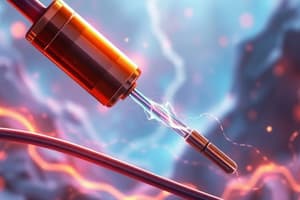Podcast
Questions and Answers
What is the name of the effect that explains the working principle of a thermocouple?
What is the name of the effect that explains the working principle of a thermocouple?
Seebeck Effect
Why are thermocouples considered active transducers?
Why are thermocouples considered active transducers?
They do not require an external power source to operate.
What is the purpose of the reference junction or cold junction in a thermocouple?
What is the purpose of the reference junction or cold junction in a thermocouple?
- To provide a stable temperature reference. (correct)
- To amplify the generated e.m.f.
- To measure the unknown temperature.
- To convert temperature into voltage.
The e.m.f. generated in a thermocouple is directly proportional to the temperature difference between the junctions.
The e.m.f. generated in a thermocouple is directly proportional to the temperature difference between the junctions.
Which of the following factors influence the choice of materials for thermocouples?
(Select all that apply)
Which of the following factors influence the choice of materials for thermocouples?
(Select all that apply)
What is the purpose of a protective sheath in a thermocouple?
What is the purpose of a protective sheath in a thermocouple?
Which type of thermocouple construction is most susceptible to noise from ground loops?
Which type of thermocouple construction is most susceptible to noise from ground loops?
Thermocouples can be used for very high precision temperature measurements.
Thermocouples can be used for very high precision temperature measurements.
What is the main disadvantage of placing a thermocouple at a large distance from the measuring device?
What is the main disadvantage of placing a thermocouple at a large distance from the measuring device?
What is the term used for the constant that relates the temperature difference to the generated e.m.f. in a thermocouple?
What is the term used for the constant that relates the temperature difference to the generated e.m.f. in a thermocouple?
The upper temperature range of a thermocouple is always limited by the melting point of the metal components.
The upper temperature range of a thermocouple is always limited by the melting point of the metal components.
Match the following thermocouple types with their primary metal combinations:
Match the following thermocouple types with their primary metal combinations:
What does the term 'Seebeck Coefficient' signify in relation to thermocouples?
What does the term 'Seebeck Coefficient' signify in relation to thermocouples?
The thermocouple's temperature sensitivity refers to the change in output voltage for a given change in temperature.
The thermocouple's temperature sensitivity refers to the change in output voltage for a given change in temperature.
Flashcards
What is a thermocouple?
What is a thermocouple?
A thermocouple is a temperature sensor that converts temperature variations into voltage.
Are thermocouples active or passive transducers?
Are thermocouples active or passive transducers?
Thermocouples are active transducers because they don't require an external power source to operate.
What are thermocouples made of?
What are thermocouples made of?
They are constructed from two wire leads made of different metals.
What is the junction in a thermocouple called?
What is the junction in a thermocouple called?
Signup and view all the flashcards
How does a thermocouple produce voltage?
How does a thermocouple produce voltage?
Signup and view all the flashcards
What factors determine the type of thermocouple required?
What factors determine the type of thermocouple required?
Signup and view all the flashcards
What is the Seeback Effect?
What is the Seeback Effect?
Signup and view all the flashcards
How is the EMF generated in a thermocouple related to temperature?
How is the EMF generated in a thermocouple related to temperature?
Signup and view all the flashcards
What is the measuring junction in a thermocouple?
What is the measuring junction in a thermocouple?
Signup and view all the flashcards
What's the reference junction in a thermocouple for?
What's the reference junction in a thermocouple for?
Signup and view all the flashcards
What happens to the EMF when both junctions are at the same temperature?
What happens to the EMF when both junctions are at the same temperature?
Signup and view all the flashcards
What's the equation for EMF in a thermocouple?
What's the equation for EMF in a thermocouple?
Signup and view all the flashcards
How can the equation for EMF in a thermocouple be simplified?
How can the equation for EMF in a thermocouple be simplified?
Signup and view all the flashcards
What factors influence the choice of materials for thermocouples?
What factors influence the choice of materials for thermocouples?
Signup and view all the flashcards
What limits the upper temperature range of a thermocouple?
What limits the upper temperature range of a thermocouple?
Signup and view all the flashcards
What is an exposed thermocouple?
What is an exposed thermocouple?
Signup and view all the flashcards
What is a grounded thermocouple?
What is a grounded thermocouple?
Signup and view all the flashcards
What is an ungrounded thermocouple?
What is an ungrounded thermocouple?
Signup and view all the flashcards
What is the advantage of a thermocouple's fast response?
What is the advantage of a thermocouple's fast response?
Signup and view all the flashcards
What's the benefit of using a thermocouple for point measurements?
What's the benefit of using a thermocouple for point measurements?
Signup and view all the flashcards
What is a disadvantage of a thermocouple's accuracy?
What is a disadvantage of a thermocouple's accuracy?
Signup and view all the flashcards
Why do thermocouples need protection from contamination?
Why do thermocouples need protection from contamination?
Signup and view all the flashcards
Why can distance cause errors in thermocouple measurements?
Why can distance cause errors in thermocouple measurements?
Signup and view all the flashcards
What are the characteristics of a J-type thermocouple?
What are the characteristics of a J-type thermocouple?
Signup and view all the flashcards
What are the characteristics of a K-type thermocouple?
What are the characteristics of a K-type thermocouple?
Signup and view all the flashcards
What are the characteristics of a T-type thermocouple?
What are the characteristics of a T-type thermocouple?
Signup and view all the flashcards
What are the characteristics of an E-type thermocouple?
What are the characteristics of an E-type thermocouple?
Signup and view all the flashcards
What are the characteristics of an S-type thermocouple?
What are the characteristics of an S-type thermocouple?
Signup and view all the flashcards
Study Notes
Thermocouples
- Thermocouples are temperature sensors that convert temperature variations into voltage measurements. They are considered active transducers because they don't need an external power source.
- Constructed from two dissimilar metal wires, welded together at a junction.
- Temperature changes at the junction result in a voltage developed across the junction.
- Different metal combinations create various voltage responses, leading to different thermocouple types for specific temperature ranges and accuracies.
- Considerations for choosing a thermocouple include required temperature accuracy, durability of the device, and the intended use conditions.
Thermocouple Working Principle
- Based on the Seebeck effect: When a closed circuit is formed from two dissimilar metals with junctions at different temperatures, an electromotive force (e.m.f.) is generated.
- The e.m.f. is proportional to the temperature difference between the junctions.
- A typical circuit has two junctions (hot and cold junctions). The hot junction is the measurement point, while the cold junction is a reference point (usually kept at 0°C).
- A PMMC meter (Permanent Magnet Moving Coil) measures the induced e.m.f. and thus the temperature difference.
Thermocouple Advantages
- Respond quickly to temperature changes.
- Convenient for measuring temperature in one point of any apparatus or setup.
Thermocouple Disadvantages
- Low accuracy, making them unsuitable for high-precision measurements.
- Requires protection to prevent contamination for extended lifespan.
- Errors may increase if the measuring device and the thermocouple are far apart.
Thermocouple Materials
- Different combinations of metals are used in thermocouples, each creating a unique e.m.f. corresponding to the temperature difference.
- Selection of metals depends on the intended temperature range and the environment (oxidizing or reducing atmosphere) where the thermocouple will be used.
- Common types include J, K, T, E, and S thermocouples, each with varying temperature ranges, sensitivity, and metal compositions. Specific characteristics are contained in Table 1.
Thermocouple Construction
- Thermocouples can have different constructions, including exposed and grounded types.
- Exposed thermocouples lack a protective sheath, for direct heat transfer, generally faster response.
- Grounded thermocouples are welded to a sheath, offering more protection against harsh environments, and an electrical contact, possibly increasing noise from ground loops.
- Ungrounded types use an insulating layer between the sensor and sheath for slower response, avoiding electrical contact problems.
Studying That Suits You
Use AI to generate personalized quizzes and flashcards to suit your learning preferences.




